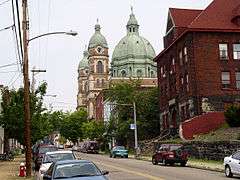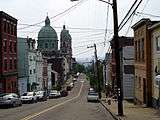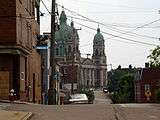Immaculate Heart of Mary Church (Pittsburgh)
| Immaculate Heart of Mary Church | |
|---|---|
| Kościół Matki Boskiej | |
 View of the church looking east on Brereton Street | |
 Location within the City of Pittsburgh | |
| General information | |
| Type | Parish church |
| Architectural style | Polish Cathedral style |
| Address | 3058 Brereton Avenue |
| Town or city | Pittsburgh, Pennsylvania |
| Country | United States |
| Coordinates | 40°27′23″N 79°58′4″W / 40.45639°N 79.96778°WCoordinates: 40°27′23″N 79°58′4″W / 40.45639°N 79.96778°W |
| Construction started | July 31, 1904 |
| Inaugurated | December 3, 1905 |
| Design and construction | |
| Architect | William P. Ginther[1] |
| Website | |
|
www | |
| Designated | 1970[2] |
Immaculate Heart of Mary Church in Pittsburgh, referred to in Polish as Kościół Matki Boskiej, is a historic church of the Roman Catholic Diocese of Pittsburgh, one of the city's oldest and largest churches.[3] Located on Polish Hill in Pittsburgh, Pennsylvania, it is a prime example of the so-called 'Polish Cathedral' style of churches in both its opulence and grand scale.
History
Immaculate Heart of Mary was founded in 1897 as a Polish ethnic parish.[4] Beginning in 1885, Polish immigrants began settling on Herron Hill in Pittsburgh. Eventually so many immigrants settled there that the area was renamed Polish Hill. At first, the residents attended St. Stanislaus parish in the Strip District, but by 1895, the population of Polish Hill grew to the point that a committee of local citizens petitioned the bishop for their own parish.[4] Permission was granted and the cornerstone of a combined church, school, and convent was laid in October 1896.[4] The completed building was dedicated in August 1897.
The first floor of the building served as a school and the second floor served as the church. In 1899, the parish purchased land for a larger church. A prolific Akron, Ohio, architect William P. Ginther who specialized in ecclesiastical buildings[5] designed the new structure, which was awarded a Pittsburgh Historic Landmark designation. The cornerstone was laid on July 31, 1904,[4] and the completed church was dedicated on December 3, 1905. Like a number of other Polish churches in the so-called Polish Cathedral style such as St. Mary of the Angels in Chicago or St. Josaphat's Basilica in Milwaukee, the architectural plans for the church were intentionally modeled on St. Peter's Basilica in Rome. This church still serves the community of Polish Hill today.
This parish was the first in the United States of America to have the Divine Mercy Novena.[4] They continue to have the novena and to have a very large celebration of Divine Mercy Sunday, the Sunday immediately after Easter Sunday.
Gallery
- Immaculate Heart of Mary Church, Polish Hill
-

View looking west on Brereton Street.
-

View looking west on Dobson Street.
-

View from front of structure.
References
- ↑ "Historic Landmark Plaques: 1968–2009" (PDF). Pittsburgh History & Landmarks Foundation. p. 3. Retrieved July 21, 2011.
- ↑ Historic Landmark Plaques 1968-2009 (PDF). Pittsburgh, PA: Pittsburgh History & Landmarks Foundation. 2010. Retrieved 2010-07-02.
- ↑ No Author Listed. "A History of Polish Hill and the PHCA". Retrieved 2006-12-22.
- 1 2 3 4 5 "Parish History". Immaculate Heart of Mary Church. Retrieved July 20, 2011.
- ↑ "Unsung Hero of Architecture". http://www.thecatholicmoment.org/archive/2013/03-10/unsung-hero-of-architecture.html. External link in
|website=(help);
- Toker, Franklin (1994) [1986]. Pittsburgh: An Urban Portrait. Pittsburgh: University of Pittsburgh Press. ISBN 0-8229-5434-6.
| ||||||||||||||||||||||||||||||||||||||||||||||||||||||||||||||||||||||||||||||||||||||||||||||||||||||||||||||||||||||||||||||||||||||||||||||||||||||||||||||||||||||||||||||||||||||||||||||||||||||||||||||||||||||||||||||||||||||||||||||||||||||||||||||||||||||||||||||||||||||
